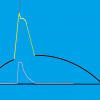-
Posts
34 -
Joined
-
Last visited
Profile Information
-
Favorite Area of Science
math
bluedot's Achievements

Quark (2/13)
2
Reputation
-
Maybe you're right. It's just the form that reminds of questions typically found in iQ tests.
-
Yes. Before opening any of the spoilers I concluded that choice 3 should be the best fit. And guess what, my reasoning was basically the same as Gideon's one. Interesting, isn't it? Well, I can't be absolutely sure we are right. Knowing the source of the puzzle would be of help. @Star Walls ? Judging by it's form, looks like IQ test question. Quick google search of the image returned this
-
First row: 2 boxes with white dots, 1 box with a black dot Second row: 2 boxes with white dots, 1 with black dots. Same thing with columns. Sort of inductive reasoning per see. You either see it or not. One may complain the sample is rather small, but that's almost always the case with such puzzles
-
Shouldn't be pretty obvious there are not supposed to be any black dots in the solution? That eliminates everything except choice between 3 and 4. Now, consider relation between change of the number of dots and rotation steps changes. Note that number of dots in the box corresponds to the number of ccw rotational steps determining occupied quadrant of each next box (in a row or column). @Ghideon got it, answer 3 is the best fit according to that logic.
-
Probably, line of same color represents the rule how number(s) change position in connected cells. However, there must be order of actions ( ie, some colors actions come before others) in order to work like that. Otherwise, doesn't make sense
-
Don't bother. At one German distributer I finally found one small relay with operating time 5 ms and release time 3.5 ms that satisfy my needs.
-
Well, it was you who informed CPC offer cheap el-mech relays with 8 ms switching times. You didn't point to any link or catalogue of such. So, I went to their sales page and didn't find any such (perhaps, there is but I can't find it). Only cheap relays with times like linked in post #6. Then I asked about max switching frequency of that relay wondering about meaning of terminology in data sheet. I got indefinite answer, while answer for upper possible frequency is easy to derive from the data. Then you gave me the link to more than fast enough but very "cheap" reed relay components. I asked you again to specify cheap relay with 8 ms switching time you had on mind. Total silence. Thanks for help!
-
It depends on electric and mechanical "inertia" of the relay system (assuming the relay is properly used within rating range). As always, knowing some of the terminology is helpful. I didn't know what exactly mean the operating time and the release time of the relay but I found out. Operating time = the time interval from the initial application of power to the relay coil until the closure of the normally open contacts. Release time = the time interval from the relay coil de-energization until re-closure of the normally closed contacts. So for the relay in post #6 data indicate the period of 1 cycle : 12 + 20 = 32 ms (at least) At least because operating and release times exclude bounce time of the contacts ( possibly it may contribute with few ms there). I conclude that this relay has max switching frequency below 30 Hz. Now, what cheap relay with times 8 ms you mention in post #3 you refered to? That one sounds promising for 50 Hz mark.
-
This looks like a solid state device with bunch of electronic components. I don't like it.
-
Can you give a link to the techical data/catalogue of one of these please? Also, there is something else I'm puzzled with. Consider data CPC gives for this one: http://cpc.farnell.com/te-connectivity-schrack/sr4m4024/relay-forced-contact-24vdc/dp/SW03967 They state an operating time 12ms and release time 20 ms. My question is what is max switching frequency for this relay?
-
Hello everybody, I'm looking for an electromechanical relay capable of high switching rate (make and break) up to 100 Hz. Relay is supposed to be for 24 V DC circuit and of small curent rating (100-200 mA). I know such a high switching rate is difficult demand for electromechanical relays, and manufacturers I contacted told me they don't have anything above 20 Hz. However, I researched myself and found in the book "Electromechanical systems in Microtechnology and Mechanotronics" the following table: Therefore, the relays I'm looking for certainly exist, but I don't know where they are used . Anybody here know something about such relays and where I can get them? Thanks
-
I thought this has been already done with photons (about 10 years ago)
-
I agree, this make sense. Due to very limited number of figures given in the sequence we can't be sure, but you have my vote for "C"
-
Tar, few posts above is my best take on Q2: #22 Therefore, my opinion is the best choice here is "B" (not "C"). But that is just my opinion and I've already changed my mind twice about that Q. What interests me the most is Q3 however
-
Quite likely becouse order of operations is irrelevant for multiplication (m*n=n*m) and for addition (m+n=n+m). IOW, solutions (3,5) and (5,3) are equally valid. If the position of polygons in boxes were of any importance, in the set of offered answers he/she would offer two boxes with changed positions of same polygons, wouldn't he/she?. Well, there is no such pair of boxes among offered answers A,B,C,D,E... As concerns Q3, I'm totally clueless about it. Maybe it is a very tricky or very stupid one, or maybe it lost colors as you said...


